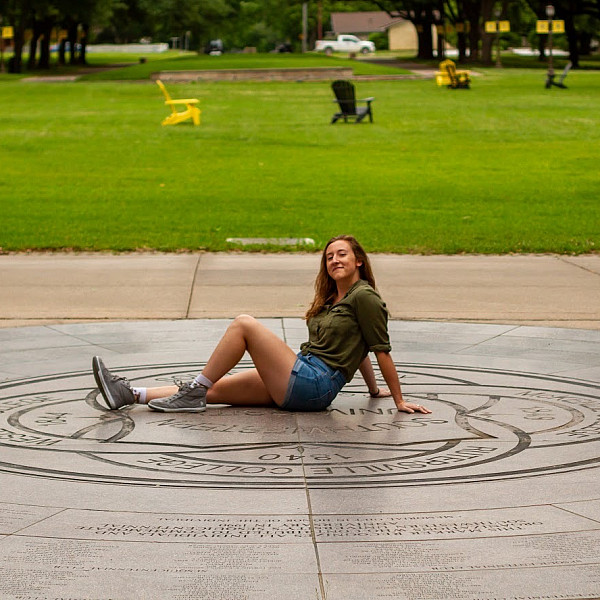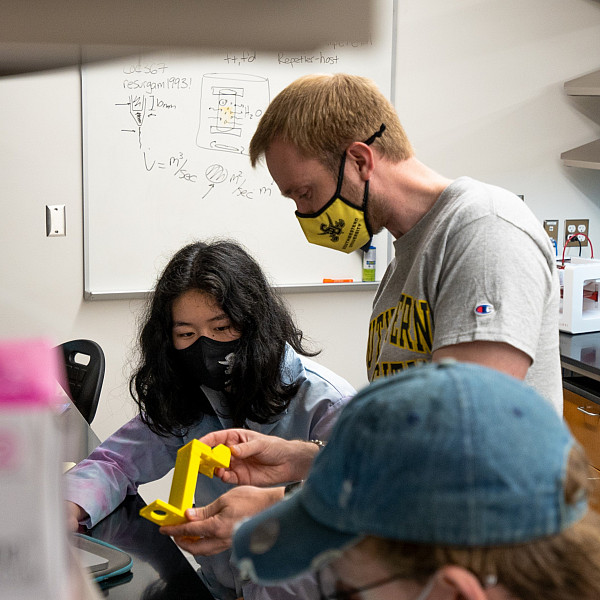News
Measuring the Light of the Universe
August 02, 2021
August 02, 2021
Open gallery

This summer, Associate Professor of Physics Mark Bottorff embarked on the Tiny Optical Telescope Multiband Observing Project (TOTMOP) at Southwestern University’s Fountainwood Observatory. Bottorff and physics majors Emily Ely ’22, Sameer Rai ’22, and Johnna Campbell ’24 have been researching how to get professionally calibrated images using a small optical telescope. Ultimately, the telescope will be used to monitor the behavior of variable stars, which are stars that dim and brighten regularly as seen from Earth, and bright active galactic nuclei, which are long-lived supermassive black holes at the center of galaxies that are the most powerful and luminous natural engines in the universe.
The project is important, Rai shares, “because it will help us better understand how to properly measure and calibrate variable stars. This way, we can find out what kind of variable star it actually is.”
Ely, who is minoring in sociology, appreciates the opportunity as part of her professional development—and because she and her colleagues are contributing to novel research. “Personally, this research is important to me because it’s the beginning of what I see myself doing as a career once I graduate from Southwestern. It’s like dipping my feet in the water to test it out,” she says. “On the other hand, it’s important for educational purposes because it opens up the field of photometry [the measure of astronomical bodies’ brightness] in astronomy and astronomical data taking.”
“Personally, this research is important to me because it’s the beginning of what I see myself doing as a career once I graduate from Southwestern. It’s like dipping my feet in the water to test it out.”
A significant part of the project includes building a flat-field device—a box-shaped device with a level, uniformly illuminated screen that fits over the lens of a telescope. The device allows the researchers to take pictures of light sources, such as stars, and eliminate the effects of dust and other tiny particles that sometimes show up in the images taken with the telescope. “If a dust particle were to appear in a picture of the sky, this flat-field device will account for that defect, especially when taking pictures of astronomical objects that are both much dimmer in light and far in distance when seen through the human eye,” Ely explains. Inside the box-shaped device, she adds, are “LED lights and a diffusion screen to better scatter the light uniformly inside the box and into the telescope and camera. Essentially, when we take exposure pictures with this device, we want a uniform, dull white picture so that it’s easier to capture and compensate for any defects.”
After setting up the small telescope in Fountainwood Observatory and completing the flat-field device—not to mention waiting out weeks of cloudy and rainy weather and figuring out how to combat the city’s light pollution, which distorts telescopic images—the team was finally able to observe several astronomical objects for two to three weeks. Campbell says this was her favorite part of the TOTMOP. Their ultimate goal then was to determine just how faint a target in the sky can be monitored using this specific equipment.

Bottorff’s students are enjoying learning how to collect and interpret quality data and taking on the challenge of constructing the flat-field device. “Since I’ve never worked with wood or carpentry, it has been difficult yet fun,” Campbell reveals.
Ely agrees. “It’s a complicated and tedious task,” she says. It’s also been challenging familiarizing herself in mere weeks with jargon such as photometry, flat-field device, and CCD cameras (i.e., charge-coupled device cameras, which are optimized for taking photographs of deep space with telescopes). “But I love challenges,” she says. “I have always doubted myself when it comes to math, measuring, and precision (things very much used in astronomy),” she shares, “and this project has helped me realize that I can do those things and that it’s fun.” Both she and Campbell found it immensely rewarding to have constructed a tool from scratch—from a mere “vague idea,” as Ely describes it—and knowing that their flat-field device can be used not just in their current research but for multiple projects going forward.
”[Dr. Bottorff] makes sure that my peers and I have had a say in the research and that what we produce is our idea guided by him. He’s a great professor, and I’m glad I am on his team.”
Math minor Rai loves the collaborative aspect of the project. “Working in a group with other fellow students and Dr. Bottorff is rewarding. I can learn advanced astronomy better than what I have before. I can learn new techniques,” he says excitedly. “Dr. Bottorff is just a fantastic advisor and teacher.” Campbell also lauds their mentor. “Working with Dr. Bottorff has been a blast!” she says. “He’s very enthusiastic and has been a great guide along the way.” Ely echoes her cohorts, saying that she loves working with the physics professor. “He teaches with passion, which makes it easier for students to engage and learn,” she shares. “He makes sure that my peers and I have had a say in the research and that what we produce is our idea guided by him. He’s a great professor, and I’m glad I am on his team.”
All three students see their TOTMOP research as a crucial stepping stone to their postgraduate plans.
Campbell, who is starting her second year at SU this fall and plans to pursue a second major in mathematics and a minor in computer science, says the project has been “something I’ve been wanting to do for a while! Experiencing this for the first time has motivated me to continue my pursuit of this field.”
Rai would love to pursue both a master’s degree and Ph.D. in astronomy or astrophysics after graduating from Southwestern in May. He believes TOTMOP is preparing him well for graduate school. He dreams of working for a major observatory, such as the University of Texas McDonald Observatory or the W. M. Keck Observatory in Hawaii.
Ely, who is also graduating this year, plans to continue her education by earning her master’s in astrophysics or astronomy. She is considering applying for the U.S. Air Force or the U.S. Space Force to gain further experience with the technical and technological equipment used in those fields before pursuing a doctorate in observational astronomy. “I feel like I have a calling,” she shares. “This TOTMOP research is only the beginning. It’s the beginning of my career of a lifetime full of studying and taking pictures of the sky… This research is helping me build up my own experience, and it’s only going to build up from here.”


















